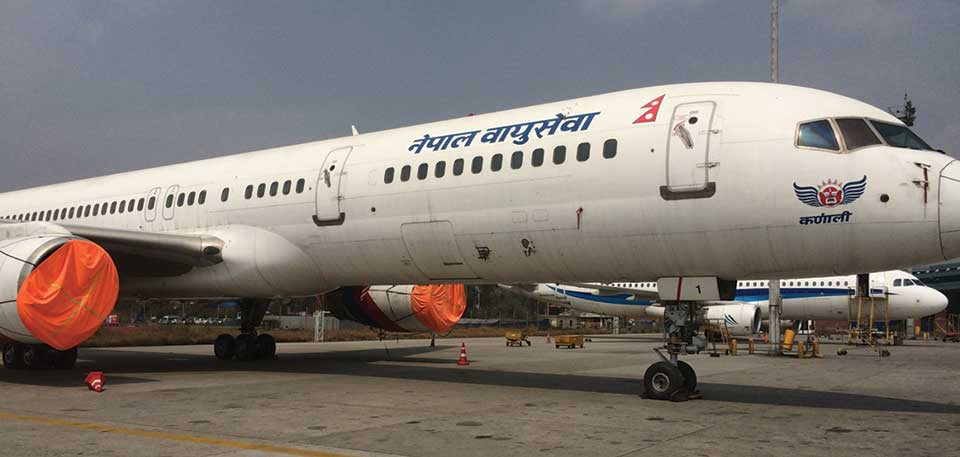
OR

B757 was popular because of the combination of brute takeoff power topped by versatility and economics of operation with sleek architecture.
General readers are perhaps baffled as to why NRA (NAC at present avatar) opted to go Airbus way rather than Boeing. A new B757 was out of the question as its production was discontinued in 2004 with the last aircraft rolling out in 2006. Its related toolings were also torn down. Securing mothballed 757s was not impossible, but it would have only added to RA’s problem given the unpleasant experience of having to manage two old ones it had. The logical question is why this aircraft is liked so much world over?
B757 was the first ever, single-aisle aircraft that came with new high “bypass” engine. In such an engine, a very large volume of air is channeled around the inner tube by the huge fan up front. A comparatively small volume of air passes through the inner tube where it gets progressively compressed, mixed with fuel and ignited. Though separated at entry, the large volume of air eventually envelopes the high-pressure jetting exhaust at the exit considerably helps in muffling sound.
I wonder if NAC will ever be entrusted to run by people with some integrity and aviation business acumen.
B757 popularity
B757 was popular because of the combination of brute takeoff power topped by versatility and economics of operation with sleek architecture as added bonus. It was equally suitable for a short hop of, say, 350nm or one ten times longer. It has proved to be one of the best aircraft built as it could operate to high altitude airports or even operate at full load with shorter runways because of powerful engines.
More crucially, it fitted perfectly in the niche transatlantic (TATL) route connecting Europe and US cities in the east coast. It was Boeing’s misfortune that this trend picked up only after the line was stopped. Established or legacy airlines found a new way to use the superb capabilities of 757 by connecting secondary cities in one continent with a major hub in another. Further, airlines could use the 757s in main truck routes during offseasons too. The specialized version of 757 were more ETOPS (Extended-range Twin-engine
Operational Performance Standards) capable of making it perfectly safe to fly hours away from nearest land. ETOPS is exclusively related to the reliability of the engine and this helped bring TATL routes comfortably within 757’s domain.
The oldest 757 that is currently active first flew some 35 years ago. The first one with NAC (9N-ACA) was delivered in September 1987 but sits like a dead duck occupying the premium parking space even if sold. The second one (ACB), 163rd produced, still flies intermittently at 29, but is put to more rigorous duties when much younger A320s get sick. It is amazing that 42 frames, older than 29, are still flying around while 80, that stand stored currently, can still be called on to fly if required. This speaks volume about the robustness of 757.
A total of 914/B757-200 (752 in short) were produced. Seating about 160, B757-100 was projected as a successor to tri-engine B727. But its first two customers (Eastern Airlines and British Airways) both preferred having B752 over 751 as it offered excellent per seat operating costs and had a full payload range of 3,850 nm (7130 km). B757 ended doing the unforeseen by replacing vintage four holer giants like B707s and DC8s.
But 752 got to a rather slow start as it took years to land further new orders. It was sold to US domestic carriers in large numbers due to American’s preference for frequency over volume as it was neither too big nor too small. A limited number (130 or so) of its larger derivative (B753) were also built and it carried 50 more pax and additional cargo.
What now?
B757 termination has compelled airlines to look elsewhere for a product that is better if not at par. Boeing is said to be in a dilemma whether to commit for an entirely new clean sheet aircraft for the sector known as the middle of the market (MOM). At any case the new aircraft will not be debuting before 2025/26. It may be too late by then as Airbus has a new derivative A321LR that can fly 4000nm with 240 on board. The A320 family of aircraft includes A319/ 320/321 along with their respective ‘neo’ versions. These, more or less, cover the lower end of the market spectrum. Incidentally, A320 is the base model, 319 and 321 are basically its squeezed and stretched versions.
The long and ultra long haul sectors, in the upper reaches, are covered by A350 and A380 as we know. But the void in the middle, created by B757’s absence, offered a perfect opportunity for Airbus to fill it with A321neo. A321LR is nothing but an A320neo with extended range arrived at by sacrificing payload with additional fuel tanks.
It is expected to be delivered to the first customer towards the end of 2018. Not just established airlines but even low-cost carriers (LCC) are gearing up to fly TATL and some of those have already opted for A321LR. It used to be a “no-go” for LCCs because of the long flight hours and need to provide in-flight services. But this seems to be changing with A321LR.
In all likelihood, A321LR would not have happened if B757 was still around. Would NAC have opted for an Airbus even so? The answer possibly will be in the negative. Now that NAC has A320s, will it go for, say, A321neo next, as it aspires to augment the narrow body fleet? It will basically depend on how the NAC is manipulated during K P Oli’s regime. “Skimming off the cream” was the usual policy of successive past governments. I wonder if NAC will ever be entrusted to run by people with some integrity and aviation business acumen.
harjyal@yahoo.com
You May Like This

UML, Maoists for middle path on disputed issues
KATHMANDU, Feb 14: A day after agreeing to rotate the party leadership, UML Chairman KP Oli and CPN (Maoist Center) Chairman... Read More...

Mother-to-be poses in the middle of dramatic storms
A brave mum-to-be posed for these stunning maternity snaps in the middle of dramatic storms. ... Read More...

Qatar Airways named ‘Best Middle Eastern Airline’
KATHMANDU, Oct 4: Qatar Airways said Monday it had been honored with the title of Best Middle Eastern Airline for... Read More...

Just In
- Govt padlocks Nepal Scouts’ property illegally occupied by NC lawmaker Deepak Khadka
- FWEAN meets with President Paudel to solicit support for women entrepreneurship
- Koshi provincial assembly passes resolution motion calling for special session by majority votes
- Court extends detention of Dipesh Pun after his failure to submit bail amount
- G Motors unveils Skywell Premium Luxury EV SUV with 620 km range
- Speaker Ghimire administers oath of office and Secrecy to JSP lawmaker Khan
- In Pictures: Families of Nepalis in Russian Army begin hunger strike
- New book by Ambassador K V Rajan and Atul K Thakur explores complexities of India-Nepal relations















_20240419161455.jpg)


Leave A Comment